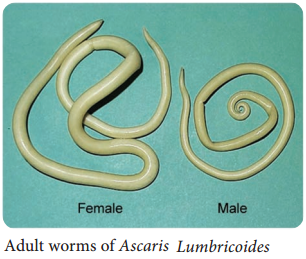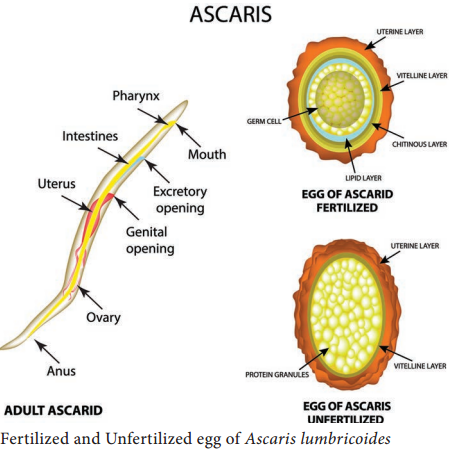Learninsta presents the core concepts of Microbiology with high-quality research papers and topical review articles.
Ascaris Lumbricoides
Geographical Distribution
It is the most common of human helminthes and is distributed worldwide.
Habitat
The adult worms lives in the small intestine particularly in jejunum and in ileum.
Morphology
Adult worm Ascaris lumbricoides resembles and sometimes confused with the earthworm. Its specific name lumbricoides means earthworm in Latin. Male and Female worm of Ascaris lumbricoides are shown in Figure 8.15.

- They are large cylindrical worms with tapering ends. The anterior end being thinner than the posterior end. It is the largest intestinal nematode parasitizing man.
- The life – span of the adult worm is less than a year.
Male worm
- The adult male worm is smaller than female worms.
- The tail – end (Posterior end) of the male worm is curved ventrally to form a hook and 2 curved copulatory spicules.
Female worm
- The adult female worm is larger (20-40 cm) and thicker (3-6 mm) than male worm.
- The posterior end is conical and straight. The anus is in the sub terminal part and opens like a transverse slit on the ventral surface.
- The vulva is situated mid – ventrally, near the junction of the anterior and middle thirds of the body. This part of the worm is narrow and is called the vulvar waist.
- A single worm lays up to 200,000 eggs per day.
Egg:
Two types of eggs are passed in feces by the worms.
Fertilized Egg
- The fertilized eggs are produced by fertilized females.
- The eggs are round or oval in shape and measures 45 µm in length and 35 µm to 50µm in breadth.
- They are bile – stained and appear as golden brown (brownish) in colour.
- The egg is surrounded by a thick smooth shell with an outer albuminous coat (corticated eggs). Sometimes this outer coat is lost in few eggs. Those eggs are called as decorticated eggs (Figure 8.16).
- Each egg contains a large unsegmented ovum with a clear crescentic area at each pole. The eggs float in saturated solution of common salt.

Unfertilized egg
- The female even not fertilized by male is capable of liberating eggs. These unfertilized eggs are narrower, longer and elliptical in shape.
- These are heaviest of all the helminthic eggs – It measures about 80µm × 105µm in size.
- The eggs have a thinner shell with an irregular coating of albumin (Figure 8.16).
- These eggs do not float in saturated solution of common salt.
Life – Cycle
The life – cycle of A. lumbricoides is completed in a single host, human (Figure 8.17).
Infective form:
Ermbryonated eggs. The fertilized egg passed in feces is not immediately infective. It has to undergo a period of development in soil. The development usually takes from 10-40 days. The embryo moults twice during the time and becomes the infective rhabditiform larva.
Mode of transmission:
Man acquires the infection by ingestion of food, water or raw vegetables contaminated with embryonated eggs of the round worm. The ingested eggs reach the duodenum to liberate the larvae by hatching. These larvae then penetrate the intestinal wall and are carried by the portal circulation to the liver. They live in liver for 3 to 4 days. Then they are carried to the right side of the heart, then to lung. In the lung, they grow and moult twice.
After development in the lungs, in about 10-15 days, the larvae pierce the lung capillaries and reach the alveoli. Then they are carried up the respiratory passage to the throat and swallowed back to the small intestine.
In the small intestine, the larvae moult finally and develop into adults. They become sexually mature in about 6-12 weeks. The fertilized female start laying eggs which are passed in the faces to repeat the cycle.
Pathogenesis
Infection of A. lumbricoides in human is known as ascariasis. The adult worm may produce its pathogenic effects in the following ways.
a. The spoliative or nutritional effects is usually seen when the worm burden is heavy. Presence of enormous numbers (sometime exceeds 500) often interferes with proper digestion and absorption of food. Ascariasis may contribute to protein – energy malnutrition and vitamin A deficiency.
b. The toxic effects is due to the metabolites of adult worm. Ascaris allergens produce various allergic manifestations such as fever, urticaria and conjunctivitis.
c. The mechanical effects are the most important manifestations of ascariasis. In heavy infections, adult worms can cause obstruction and inflammation of intestinal tract, particularly of the terminal ileum.
d. Ectopic ascariasis (Wander lust) is due to the adult male worms. They are restless wanderers. The wandering happens when the host temperature rises above 39°C. The worm may wander up or down along the gut. It may enter the biliary or pancreatic duct causing acute biliary obstruction or pancreatitis. It may enter the liver and lead to liver abscesses.
The worm may go up the esophagus and come out through mouth or nose. It may crawl into the trachea and the lung causing respirator obstruction or lung abscesses. Migrating downwards, the worm may cause obstructive appendicitis. The worm may also reach kidneys. “Larva migrans” is a term used when the larval sworms migrate to various parts of the body.
Clinical Manifestations
Incubation Period is 60-70 days. Clinical manifestations due to adult worm vary from asymptomatic to severe and even fatal infection. Clinical manifestation in ascariasis can be caused either by the migrating larvae or by the adult worms.
Symptoms due to the migrating larvae:
Leads to ascaris pneumonia and larvae may enter the general circulation, disturbances have been reported in the brain, spinal cord, heart and kidneys.
Symptoms due to the adult worms:
Diffuse or epigastric abdominal pain, abdominal cramping, abdominal swelling (especially in children), fever, nausea, vomiting and passing roundworms and their eggs in the stool.
Laboratory Diagnosis
Specimen collected: Stool, sputum and blood.
Detection of parasite
Adult worm:
It can be detected in stool or sputum of patient by naked eye. Pancreatic or biliary worms can be detected by ultra-sound and endoscope.
Larvae:
Larvae can be detected in sputum and often in gastric washings. Chest X – ray may show pulmonary infiltrates.
Eggs:
Detection is through demonstration of eggs in feces. Detection of both fertilized and unfertilized eggs are made after staining. Eggs may be demonstrative in the bile obtained by duodenal aspirates.
Blood Examination
Complete blood count may show eosinophilia in early stage of infection.
Serological tests
Ascaris antibody can be detected by IHA, IFA and ELISA
Treatment
Commonly used drugs are Albendazole and Mebendazole.
Prevention and Control
- Proper health education should be given for improved sanitation and personal hygiene.
- Avoid eating of uncooked green vegetable, food preparation and fruits that may contain faecal eggs.
- Treating infected persons especially children. Deworming of school children have been found effective in control of ascariasis.